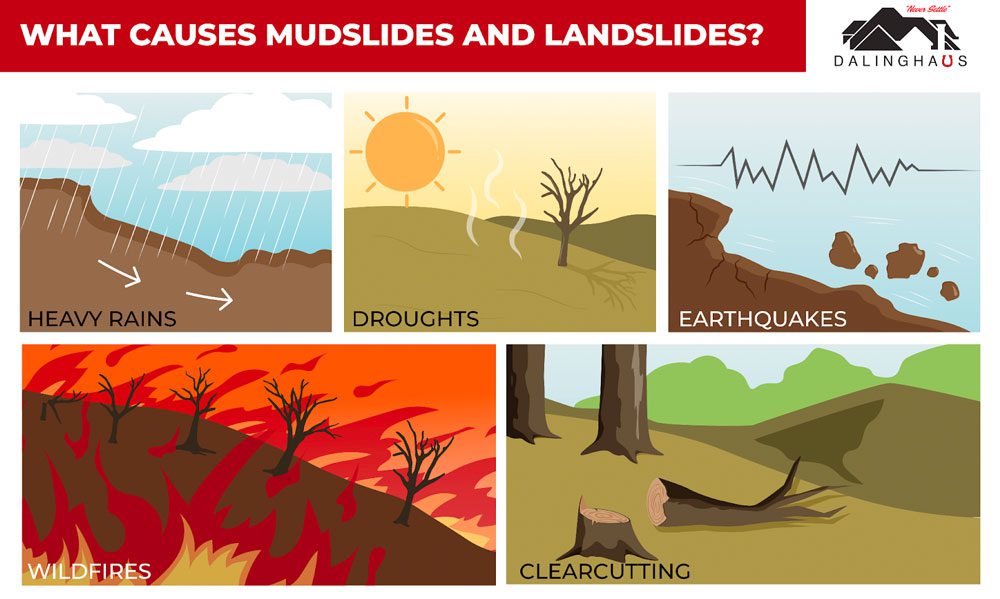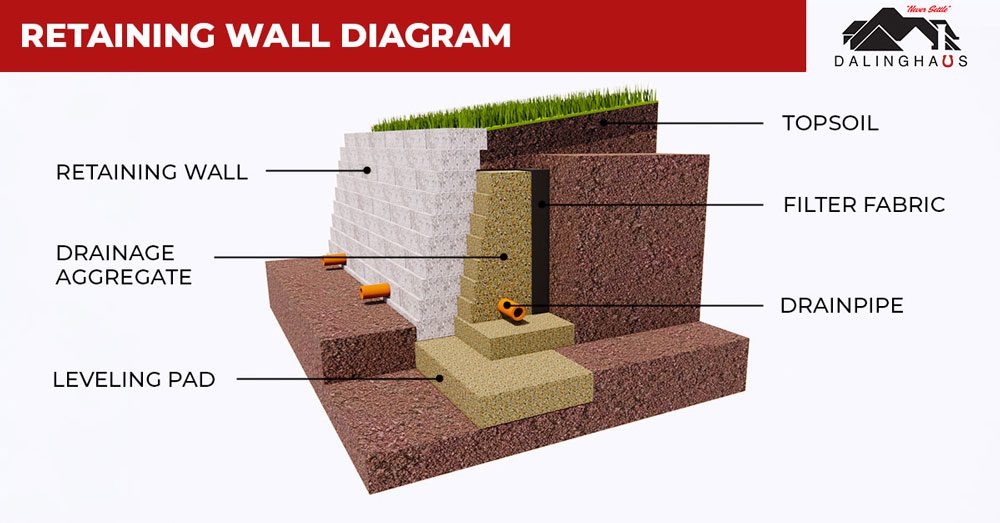Preventing a landslide or a mudslide through slope stabilization can protect your family and property from immeasurable damage. Keep reading to find out what causes landslides, how to anticipate them, and the best way to prevent them through different slope stabilization methods.
What Causes Mudslides and Landslides?
Landslides and mudslides can occur due to any activity or event that affects the stability of a slope. There are six major causes of landslides: heavy rain, droughts, earthquakes, wildfires, and clearcutting.
Heavy Rain
Heavy rain saturates the soil and can reduce the friction between soil particles, making the soil more prone to movement. In areas with loose or poorly compacted soil, the cohesion between soil particles is already weak, increasing the likelihood of a mudslide. As the soil becomes saturated and heavier, the soil slides downhill. The water also acts as a lubricant, making the soil slide easier.
Droughts
Drought conditions lead to the drying and shrinking of soil. As the soil dries out, it contracts and develops cracks, reducing its cohesion and stability. Dry soil can create weak zones within the soil, making it more susceptible to sliding when disturbed by factors such as heavy rainfall or human activities. Drought also causes groundwater levels to drop. Groundwater is a natural support for slopes by exerting pressure on the soil, helping to hold it in place. When groundwater levels drop significantly, it can lead to slope destabilization and increased risk of landslides.
Earthquakes
Earthquakes can cause landslides through direct ground shaking, ground rupture, liquefaction, and other associated processes. The magnitude and duration of the quake, a slope’s characteristics, and the affected area’s geological and environmental conditions will determine the mudslide or landslide’s severity.
Wildfires
Wildfires can burn away vegetation that stabilizes soil and prevents erosion. Intense heat from wildfires can also alter the physical properties of soil, reducing its ability to absorb moisture, increasing runoff, and increasing the risk of mudslides and landslides during heavy rainfall.
Clearcutting
Clearcutting increases the risk of mudslides and landslides by removing vegetation, disrupting soil structure, and increasing surface runoff, making the soil more susceptible to sliding during heavy rainfall.

What Kind of Damage Can Mudslides and Landslides Cause?
Mudslides and landslides can cause significant damage to homes and structures in several ways:
- Direct Impact – Large volumes of soil, rock, and debris can crash into buildings, walls, and foundations with such intense force that the building can sustain major damage or collapse. It can also bury the structure or block entrances, posing safety hazards and hindering rescue efforts.
- Foundation Undermining – Mudslides and landslides can undermine the foundations of homes, weakening or destabilizing them. The soil movement can erode the supporting soil beneath the foundation, causing it to sink, tilt, or crack. Erosion can compromise the structural integrity of the entire building, leading to costly repairs or even collapse.
- Utility Damage – Mudslides and landslides can damage or destroy utility lines, including water, sewer, gas, and electrical lines, disrupting essential services and posing safety hazards. Damage to utility lines can also increase fire risk, electrocution, or gas leaks.
- Land Movement – Besides immediate structural damage, mudslides and landslides can cause long-term land movement, slope instability, and soil erosion around homes. This ongoing movement can further compromise the stability of structures and increase the risk of future damage or collapse.
Can I Anticipate a Mudslide or Landslide?
While it is almost impossible to predict exactly when or where a mudslide will occur, there are numerous factors to consider that can help:
- History of mudslides and landslides – Historical records of landslide events, land use changes, and previous slope failures can provide valuable insights into local landslide hazards. Understanding past landslide occurrences and their triggers can help anticipate future landslide events and inform risk mitigation measures.
- Changes in drainage and landscaping – Visual observations of slope features, such as cracks, bulges, slumps, or tilting of trees or structures, can indicate potential slope instability. Changes in surface drainage patterns, including new springs or seeps, pooling of water, or sudden changes in streamflow, may also suggest underlying ground movement and the increased possibility of a mudslide or landslide.
- Widening cracks in your foundation or driveway – If you see sudden cracks that expand rapidly, this could be an early sign of a landslide.
- Weather changes – Since heavy rainfall and drought can lead to mudslides and landslides, monitoring weather changes can help you prepare for potential landslides.
Want to see an example of how our experts predicted a landslide? Watch this video:
How Can I Prevent a Mudslide or Landslide from Damaging My Home?
Since mudslides and landslides are so dangerous and are difficult to anticipate, the best way to prevent them from affecting your home is by stabilizing slopes on your property and diverting debris pathways. Consider the following methods:
- Regrade your slope – The simplest solution for stabilizing your slope is to add soil so that the slope is less steep, which reduces erosion from flowing surface water. Unfortunately, if you have limited space to add soil, you may need to try another method.
- Soil Nailing – This involves grouting steel bars into the soil to provide added stability to the soil on a slope, preventing movement.
- Rock Bolts – If you have a rocky slope, rock bolts can reinforce the rock mass and prevent rocks from falling.
- Add a drainage system – Installing a French drain can help intercept water that flows down the slope and reduce erosion during heavy rainfall.
- Install appropriate landscaping – Plant roots help stabilize soil and prevent erosion. Creeping ground covers, turf, and vines are popular choices since they are easy to maintain, and their free growth patterns help with soil stabilization.
- Build a retaining wall – Retaining walls are complex but highly effective at preventing landslides and directing debris and water flow. They are engineered to hold heavy loads of soil in place against gravity while incorporating advanced drainage systems to provide reliable protection from landslides and mudslides.

To learn more about slope stabilization, watch our YouTube video:
What Should I Do If a Mudslide or Landslide Has Damaged My Foundation?
If a mudslide or a landslide has damaged your home and its foundation, stay safe by staying away from the site and contacting the appropriate professionals. Immediately after a landslide, call emergency services to report the landslide and receive immediate help. Once it is safe to enter the property, assess the damage and work closely with your insurance agent.
If you suspect the landslide has damaged your foundation, contact a reputable repair company. They will inspect the foundation and provide a repair plan. From fixing cracks to mitigating differential settlement, Dalinghaus Construction provides the best solutions.
The best way to protect your home and family from a mudslide or landslide is to prevent it! Contact Dalinghaus Construction and schedule an appointment to discuss which slope stabilization methods are best for preventing landslides in your area. We service California, Nevada, and Arizona.






